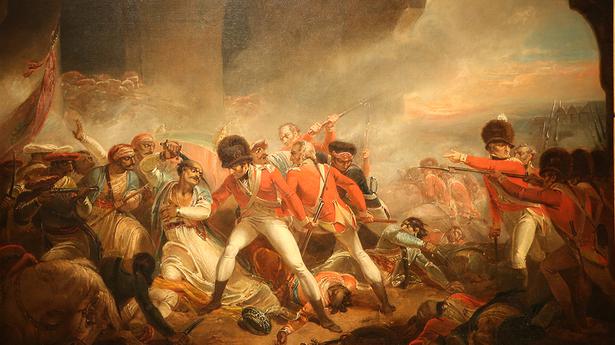
Henry Singleton’s painting of Tipu Sultan now in India
The Hindu
Giles Tillotson, curator of Tipu Sultan: Image & Distance, an exhibition in New Delhi on the visual history of the Anglo-Mysore Wars, explores the public narrative surrounding these events over two centuries
This is art tilled from the soil of the Deccan but painted in Georgian London in 1800 by an artist who had never visited India. And yet, in colours so gem-like and reminiscent of the subcontinent, Henry Singleton captures the fall of the ruler of Mysore in the Last Effort and Fall of Tippoo Sultaun. In it, smoke spews and horses and bodies tumble as British red-coats fire at the Mysore Army rallying around a frayed standard. Tipu, an implacable enemy of the British East India Company, has his sword raised, even as he meets his death, in what is a scene depicting the fall of Srirangapatna in the Fourth Mysore War (1799).
The painting that was made for a British audience spent the whole of its 200 years in England, but is now in India after art company DAG that collaborates with stellar art institutions, acquired it and organised an exhibition of 92 works with Tipu Sultan as its focus.
In the vast pantheon of kings who have been the subject of colonial-era art, why Tipu? Giles Tillotson, senior vice president, Exhibitions at DAG and curator of the exhibition at The Claridges, New Delhi, says over phone, “It was brought about by the acquisition of the Singleton by Ashish Anand [CEO, DAG]. It is one of the most important historical paintings produced by a British artist on an Indian subject. Most of the works are in public collections in the UK, at the India Office Library or at the V&A but this one was in private hands. As a registered antiquity bought in London and imported to India, it will never leave the country again. A lot of the other works around Tipu were issued as prints and it’s not that hard to collect them, like the beautiful watercolour of Coorgi raja Dodda Vira Rajendra who allied with the British against Tipu. And just like that, we had enough for an exhibition.”
The exhibition is accompanied by a book edited by Tillotson that introduces, illustrates and contextualises this body of work. A portrait of Tipu by a Deccan artist shows him in profile, mustachioed, turbaned and jewelled; it juxtaposes Anand’s foreword “his reputation remains controversial in some parts of the country and the exhibition does not claim to propose definite conclusions. But what cannot be disputed is that Tipu was the most formidable foe the British faced in India. Yet he was not accorded the same respect as others who took up arms against the British in later times...”.
The aquatints, engravings, maps and lithographs by some of the most brilliant illustrators to chronicle the India of the late-1700s upto the mid-1800s are part of the exhibition. Most showcase Tipu in the midst of war.
“Tipu threw the most powerful challenge to the Company in the period of its greatest territorial expansion; they would not face anything else on the same scale again until the Revolt of 1857,” says Tillotson.
The book, through five chapters and an extensive art catalogue, draws attention to Tipu’s various facets. Janaki Nair, professor of History, JNU, focusses on his role as a moderniser of military technology, revenue collection and sericulture. Tillotson examines the evolution of Tipu in painting and the British imagination, especially that of Singleton, Mather Brown and Robert Ker Porter. Savita Kumari, assistant professor, National Museum Institute, discusses the visual culture of Tipu’s court, and how the same battles, especially the Battle of Pollilur in which the British were defeated, were depicted as murals on his Dariya Daulat palace walls by local artists. Drawing on archival documents, London-based historian Jennifer Howes reconstructs the stories of the women of Tipu’s court in a way that identifies these women in the paintings for the first time. Aditi Mazumdar, senior executive curator, DAG, writes on how eye witnesses such as Captain Munro perceived the Battle of Srirangapatna.













